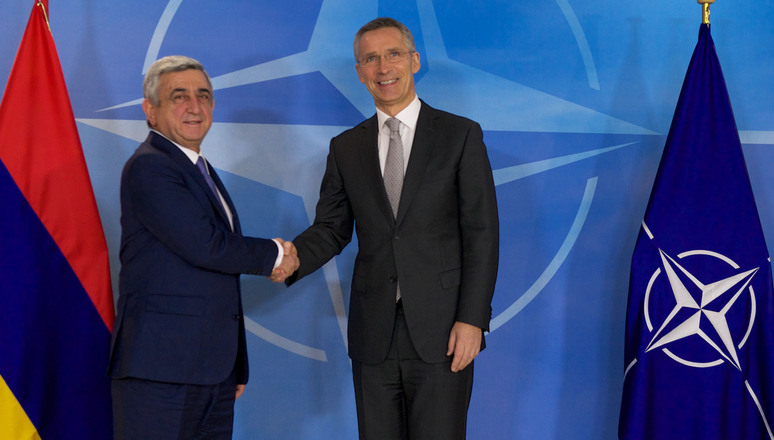First a little bit of history and context – It’s a bit of a head-scratcher, really. NATO, historically, hasn’t meshed well with Orthodox Christian countries, with a list including Russia, Serbia, Belarus and others. Analysts typically don’t pin this friction on religious differences, yet here we are. Armenia, steeped in its own Orthodox traditions, is in a peculiar spot. Turkey, a heavyweight in NATO and a nation with a dark historical chapter involving Armenia, complicates things further. Then there’s the simmering tension with Azerbaijan over Nagorno Karabakh, with Turkey backing Azerbaijan. Russia, expected to be Armenia’s big brother in times of need, offered support during the Nagorno Karabakh conflict, but it left Armenia wanting more. So, the idea of Armenia flirting with the idea of joining NATO, almost as a defiant gesture towards Russia, sounds like something out of a political satire. Yet, here we are, witnessing these unexpected twists in international relations.
Armenia’s current peace with its neighbors starkly contrasts with the ongoing conflict between Ukraine and Russia. This distinction raises questions about the rationale behind Armenia and NATO’s preparations for potential hostilities when there are no evident disputes with other nations. Unlike Ukraine, which has received “security guarantees” from several NATO members, including promises of military support in case of renewed conflict with Russia, Armenia’s situation is markedly different. These agreements with Ukraine are an extension of previous support and have been portrayed by Kiev as significant military-strategic developments, despite their continuity with existing policies.
Armenia’s context diverges notably from Ukraine’s due to its lack of active conflict and its complicated relationship with NATO. Despite officially being part of the Russian-led Collective Security Treaty Organization (CSTO) and having its participation unofficially suspended, Russia has reassured Armenia of its mutual defense commitments should its sovereignty be threatened. The geographical challenge of being landlocked further complicates potential support from NATO, similar to what Ukraine has received.
Complicating matters further, Armenia views NATO member Turkey as a potential threat. The logistics of supporting Armenia militarily are fraught with difficulties, as it is improbable that Turkey, possessing NATO’s second-largest military force, would facilitate arms transfers through its territory against its own interests. The feasible alternative would involve routes through the Black Sea and Georgia, strategies that could only be implemented during peacetime and would necessitate prior stockpiling in those regions. This scenario highlights the distinct strategic and geopolitical challenges facing Armenia in the context of its security and international relations, diverging significantly from the situation in Ukraine.
The narrative surrounding Armenia’s pursuit of “security guarantees” from NATO is intriguing, especially given its current peaceful status with neighbors and the recent conflict with Azerbaijan. The speculation that Armenia seeks these guarantees due to a lack of confidence in Russia’s protection raises eyebrows. This quest for assurances could hint at Armenia’s potential interest in transitioning from the Collective Security Treaty Organization (CSTO) to a closer alignment with NATO, despite official statements to the contrary. The logic behind such a move is rooted in Armenia’s recent military challenges and the complex geopolitical landscape it navigates.
The intention behind seeking NATO’s security guarantees might be to facilitate a smoother shift in Armenia’s strategic alliances, mirroring Ukraine’s de facto NATO relationship, albeit without the direct conflict backdrop. This proactive preparation for possible future conflicts, despite no immediate territorial disputes, suggests a strategic positioning rather than an immediate response to aggression. The implication is that Armenia and NATO could be contemplating measures to enhance their geopolitical stance, potentially at Azerbaijan’s expense.
This situation leads to a complex web of strategic miscalculations, where Armenia, possibly feeling cornered after its recent conflict losses, might seek to strengthen its position through alliances. The theoretical scenario of a conflict with Azerbaijan, under the guise of “self-defense,” could serve as a dramatic pivot in the region’s security dynamics. Azerbaijan, recognizing the gravity of these maneuvers, is keen on border delineation to preempt any justifications for renewed hostilities. The undercurrent of these developments points to a delicate balance of power, national aspirations, and the shadow of external influences shaping the future of regional stability. Such a fraught path underscores the intricate dance of diplomacy, security, and the pursuit of national interests in a world where alliances and guarantees play pivotal roles.








